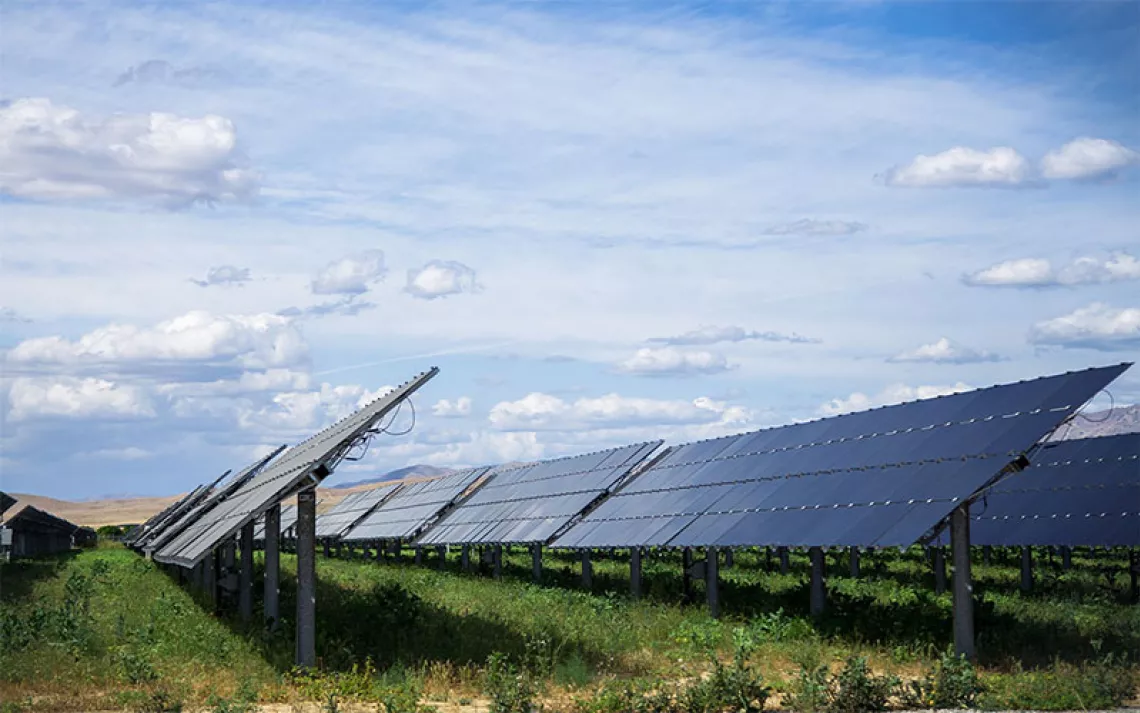Solar and Wind Poised to Soar After New Climate Law
Transmission bottlenecks remain a key hurdle for faster growth

Photo by iStock/studio-fi
Now that the landmark Inflation Reduction Act has been signed into law, it’s time to get to work on climate. President Biden said as much on August 16, hailing the law as the largest climate package in history. “Making progress in this country, as big and complicated as ours, clearly, is not easy. It's never been easy. But with unwavering conviction, commitment, and patience, progress does come,” Biden said.
The law will invest $369 billion in a long list of clean energy and climate programs. That’s big news for one sector of the green economy in particular: renewable energy.
The Inflation Reduction Act will kick new solar and wind installations into a much faster gear. The central pillar of the IRA’s climate and energy architecture is tax credits for wind and solar, which will now be in place for a decade. Instead of letting those tax credits periodically expire or step down, only to renew them for another year or two, Congress has now locked in clean energy tax credits into the early 2030s.
“For the first time, developers of wind and solar, utilities, and manufacturers and companies that want to buy that power—all have the advantage of being able to plan on a tax platform that is supportive of renewable power,” Gregory Wetstone, president and CEO of the American Council on Renewable Energy, an industry trade group, told Sierra.
Annual capacity additions could jump from 15 gigawatts of wind and 10 gigawatts of utility-scale solar PV in 2020 to an average of 39 gigawatts of wind in 2025–26 and 49 gigawatts for solar, according to modeling from Princeton University. In other words, twice as much wind power and five times the amount of solar will be installed each year compared with 2020. The proliferation of solar will grow faster still in the second half of the decade.
That alone is one of the most important pieces of the legislation. “IRA is a game changer simply by thinking longer term about the tax environment for clean energy,” Daniel T. Schwartz, director of the Clean Energy Institute at the University of Washington, told Sierra in an email.
“Even before the IRA passed, I viewed this decade as the decade of renewables,” Emily Fisher, general counsel and senior vice president for clean energy at Edison Electric Institute, a trade group for investor-owned utilities, told Sierra. “We have closed a huge portion of the coal fleet. The majority of new capacity additions in the past three years have been wind and solar, predominantly solar. So, we were already heading in this direction.”
In addition to locking incentives in for the long haul, the IRA made a series of tweaks that make the tax credits much easier to access. “A lot of the way the tax incentives have been structured in the past really favored entities that were regulated differently from investor-owned electric companies,” Fisher said.
In the past, developers of renewables projects had to partner with a bank or some Wall Street entity to get the tax credits, which “increases the complexity and cost of renewables deals,” Fisher said. Wall Street banks would eat up a portion of the credit. “We don’t necessarily have to do that now,” Fisher said. Another big win.
Up until now, non-taxpaying electricity providers such as rural electric co-ops were unable to take advantage of tax credits since they didn’t owe anything to Uncle Sam. Now they too can access the tax credits. “There's a lot of tax wonky fixes that make it easier for electric companies to use these credits,” Fisher said.
When asked broadly about the significance of the legislation, Pedro Azagra, the CEO of Avangrid, the third-largest renewables company in the country, echoed similar points. With the law, “we move away from the current bottleneck where only a few tax equity firms are buying tax credits from developers who are unable to utilize the credits,” Azagra told Sierra in an email. “We are creating a true tax equity market, which will ensure that we get the full value of this tool to help the economics of renewable energy projects.”
Energy storage will also receive a tax credit, making solar or wind combined with battery storage a routine concept going forward.
Yet there are still some impediments standing in the way, including bottlenecks for transmission. A massive amount of proposed wind and solar projects are ready for the go-ahead but are stuck waiting in long lines for approvals to be connected to the grid. The culprit is lack of transmission.
“We invested in transmission in this country in the '30s, '40s, 50's, and that's more or less the grid that we have. It was built out to connect hydro at first, and then to connect to coal seams,” Wetstone said. “That grid is antiquated; it's not as reliable as we need it to be.”
The Department of Energy affirmed that history in an April 2022 report. “More than 930 gigawatts (GW) of solar, wind, hydropower, geothermal, and nuclear capacity are currently sitting in interconnection queues seeking transmission access, along with over 420 GW of energy storage,” the authors of the report noted. “This is roughly the same amount of clean capacity needed to hit an 80 percent clean electricity share in 2030.”
The problem is that building transmission lines is an incredibly difficult and lengthy process, often getting bogged down in legal morass. “It can take seven to 10 years to build new transmission, and the vast majority of that is related to litigation over permits,” Fisher said.
In order to hit net-zero emissions by 2050, the stated goal of the Biden administration and many other countries, the United States will need two to five times the amount of transmission that we have today.
Nevertheless, the IRA means the 2020s will see enormous growth in renewable energy.
“The best possible world is when you line up the technology, the policy, and the incentives. And that is definitely where we are,” Fisher said. “This is the perfect storm for increased renewables deployment in this decade.
 The Magazine of The Sierra Club
The Magazine of The Sierra Club



